土壤肥料学国家精品课件第二章 土壤有机质
第二章土壤有机质17861PPT学习教案

三、土壤腐殖物质的分解和转化
腐殖物质的分解转化经历3个阶段:
第一阶段:腐殖物质经物理、化学和生物降解,使芳
香结构核心与其复合的简单有机物分离或使整个复合体
解体;
第二阶段:释放的简单有机物质被分解转化,酚类聚合
物被氧化;
第三阶段:脂肪酸被分解,被释放的芳香族化合物参与
新腐殖质的形成。
羧基、酚羟基、羰基、醌基、醇羟基、甲氧基等。
表 2 -4 我国 主要土 壤表土 中腐殖 物质的 含氧功 能基[cm ol(+) .kg-1]
种类 羧基 酚羟基 HA 275-481 221-347 FA 639-845 143-257
醇羟基 醌基 酮基 甲氧基 224-426 90-181 32-206 32-95 515-581 54-58 143-254 39
第15页/共74页
一、简单有机化合物的分解和转化
在好氧条件下 ,微生 物活动 旺盛, 分解作 用可进 行较快 而彻底 ,有机 物质---->CO 2和H2O ,而N、P、S等则以 矿质盐 类释放 出来。
在嫌气条件下 ,好氧 微生物 的活动 受到抑 制,分 解作用 进行得 既慢又 不彻底 ,同时 往往还 产生有 机酸、 乙醇等 中间产 物。
C/N降至大约25:1以下,微生物不再利用土壤 中的有效氮,相反由于有机质较完全的分解而释放 矿质态氮,
第25页/共74页
表 2-2 一些有机物质的碳、氮含量及其 C/N 比
有机物质 云杉锯屑 硬木锯屑 小麦秸秆 玉米禾茎
甘蔗渣 黑麦草(开花期)
草坪禾草 黑麦草(营养期)
成熟苜蓿干草 腐烂畜肥 堆肥
第19页/共74页
四、影响土壤有机质分解和转化的因素
土壤肥料学PPT课件2024新版

耕作改良
合理耕作,如深松、深翻等,改善土壤通气性。
工程措施
种植防护林、草被植物等,增加地表覆盖,防止风蚀和水蚀。
生物措施
农业措施
法律措施
01
02
04
03
制定和执行相关法律法规,加强水土保持工作。
修建梯田、水平沟等工程设施,减少水土流失。
改坡地为梯田,等高种植,合理轮作和耕作等。
增施有机肥
大量施用农家肥、绿肥等有机肥,提高土壤肥力。
合理施用化肥
根据土壤养分状况和作物需求,科学施用化肥。
深耕深松
改善土壤物理性状,增加土壤通气性和保水能力。
种植绿肥和牧草
增加土壤有机质和氮素含量,改善土壤结构。
06
CHAPTER
环境保护与可持续发展策略
化肥过量使用导致土壤污染
01
长期过量使用化肥会导致土壤板结、酸化、盐渍化等问题,严重影响土壤质量和农作物生长。
水利改良
选择耐盐作物品种,合理轮作和耕作,增施有机肥等。
农业改良
种植绿肥、牧草等,增加土壤有机质,改善土壤结构。
生物改良
施用石膏、磷石膏等化学改良剂,降低土壤碱性。
化学改良
石灰改良
施用石灰或石灰石粉等碱性物质,中和土壤酸性。
绿肥改良
种植绿肥作物,增加土壤有机质,提高土壤pH值。
肥料改良
增施碱性肥料,如草木灰、钢渣磷肥等。
避免过量施肥
不同的作物和土壤对肥料的需求有所不同,要选择适合当地土壤和作物的肥料种类。
注意肥料种类选择
掌握正确的施肥技巧,如深施基肥、集中施用种肥、及时追施叶面肥等,以提高肥料利用率和作物产量。
注意施肥技巧
04
CHAPTER
土壤学课程土壤有机质

根据耕作层中有机质含量,可将土壤分为:
有机质土壤 >20% 矿 质土 壤 <20%
三 土壤有机质的类型
新鲜的有机物
进入土壤中尚未 被微生物分解的 动、植物残体。 它们仍保留着原 有的形态等特征。
半分解的有机物
经微生物的分解, 失去动、植物残 体了原有的形态 等特征。包括有 机质分解产物和 新合成的简单有 机化合物。
其次Fe、 Ca、 Mg 、Si 。
胡敏酸 富里酸
C% 50--62 45--48
H% 2.8--6.6 5--6
O+S% 31--40 43--48
N% 2.0--6.0 1.5
一般腐殖质平均含碳为58%,氮5.6%, C/N比为10:1-12:1。
我国主要土壤表土中腐殖物质的元素组成(无灰干基)
四 影响土壤有机质转化的因素
有机质是土壤中最活跃的物质组成。
一方面,外来有机物质不断地输入土壤,并经微生物的分 解和转化形成新的腐殖质;
另一方面,土壤原有有机质不断地被分解和矿化,离开土 壤。进入土壤的有机物质与有机碳从土壤中损失之间的平衡 决定了土壤有机质的含量。 凡是能影响微生物活动及其生理作用的因素都 会影响有机物质的分解和转化。
1. 温度
微生物活动响应于温度变化:
≤0℃ :无分解。
0-35℃:分解随温度而加强,每升温10℃ ,分解速 率提高2-3倍。 25-35 ℃:最适分解温度。
2. 土壤水分与通气状况
土壤水分对有机质分解和转化的影响 土壤中微生物的活动需要适宜的土壤含水量,但过多 的水分导致进入土壤的氧气减少,从而改变土壤有机物 质的分解过程和产物。 土壤有机质的分解和转化也受土壤干湿交替作用的影响
第二章 有机质ppt课件

第一节有机质的来源、含量及组成
三、土壤有机质的组成
土壤中糖类物质的重要性
• 络合多糖可将土壤颗粒结合为稳定的团聚体。
• 多糖也可和金属离子形成络合物,并成为腐殖质合成的 建造单元;
• 氨基糖的矿化,可向植物供应N素; • 有些糖类可以刺激种子发芽和根的延伸; • 多糖还会影响土壤的阳离子代换量和微生物活性
有机物质的半分解期为4.7-9年,胡敏酸在土壤中平均停留时
间780-3000年,富里酸为200-630年。
第二节 土壤有机质的分解和转化
土壤中有机物质的转化分为矿质化和腐殖化两个过程
ቤተ መጻሕፍቲ ባይዱ
矿质化是复杂的有机物质分解为简单无机化合物(CO2和H2O)
腐殖化是分解中间产物后又合成更复杂、稳定、胶状的高
的过程,并释放出矿质养分和热量。
分子聚合物的过程,它使有机质和养分得以保存起来。
第二节
土壤有机质的分解和转化
一、矿化过程与腐殖化过程
1、矿化作用(Mineralization)***
土壤有机质在土壤微生物及其酶的作用下,分解成 二氧化碳和水,并释放出其中的矿质养分的过程。 2. 矿化作用的意义 为作物生长释放出了营养元素---有效化过程 为腐殖质形成提供了基本材料,成为腐殖化的前提。 a 酶
进入土壤的有机物质数量 土壤有机质的损失量 土壤有机碳的平衡
第一节有机质的来源、含量及组成
三、土壤有机质的组成
非腐殖质
• 结构简单、易被微生物分解、具有明确的物理化学性质的
物质,这些物质统称为非腐殖质。
• 包括土壤中的糖类物质、有机酸和一些化学结构已知的含 N化合物,如氨基酸、氨基糖等。 • 占土壤有机质的20~30%
土壤学课件第二章
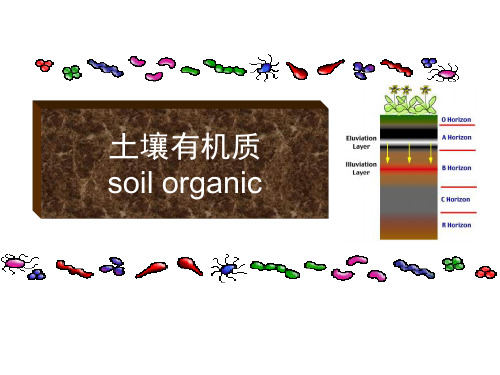
第三节 土壤腐殖质 soil humus
(一)矿化作用的概念:有机物质在微生物的作用下分解成无机 营养元素的过程 Mineralization: the conversion of an element from an organic form to an inorganic state as a result of microbial decomposition (二)矿化作用的意义 1.为作物生长释放出了营养元素---有效化过程(硝化力测定) 2.为腐殖质形成提供了基本材料,成为腐殖化的前提。 (三)各种物质矿化作用 1.糖类有机物质矿化: CO2+H2O+heat(多) 好气条件下 多糖 单糖 有机酸——heat(少) 半嫌气条件 CH4、H2、H2S+heat(极少)嫌气 水解酶作用
黄腐酸(富啡酸、富里酸)既能溶解 于碱,又能有解于酸。曾经成为可连 酸、阿波可连酸。分子量相对较小
+
=60%
褐腐酸(胡敏酸):指能溶解于碱 而不溶解于酸。分子量相对较大
三.土壤腐殖质性质
(一)腐殖酸的组成
1.腐殖酸的元素组成 腐殖酸主要由碳、氢、氧、氮、硫等元素组成。一般以腐殖质 分子的平均含碳量为58%为有机碳和腐殖质的换算系数 (1.724=100/58)。C/N=10:1~12:1,褐腐酸大于黄腐酸 我国土壤腐殖酸的元素组成(南京土壤研究所) 腐殖酸 胡敏酸 富里酸 C (%) 50~60 45~53 H (%) 3.1~5.3 4.0~4.8 N (O+S) 分子量 ( % ) (%) 31~40 2.8~5.9 890~2550 40~50 1.6~4.3 675~1450
土壤肥料学绪论课件

土壤肥料学主讲人:李志军研究员绪论第一章土壤矿物质第二章土壤有机质第三章土壤的孔性、结构性和耕性第四章土壤水第五章土壤空气和热量状况第六章土壤保肥性和供肥性第七章土壤形成、分布和分类土壤肥料学第一篇第八章植物营养与施肥原理第十二章植物中量元素营养与肥料第十一章植物的钾素营养与钾肥第十章植物的磷素营养与磷肥第九章植物的氮素营养与氮肥第十六章新型肥料与施肥新技术第十五章复混肥料第十四章有机肥料第十三章植物微量元素营养与肥料土壤肥料学第二篇第十七章土壤管理第十八章土壤退化与土壤资源保护第十九章土壤肥料资源的开发利用第三篇土壤肥料学绪论绪论第一节土壤肥料的重要性一、土壤是农业生产的基本生产资料和生产链环中物质与能量循环的枢纽1.土壤是农业生产的基地和基本生产资料2.土壤是农业生产链环中物质和能量循环的枢纽二、土壤是自然界中具有再生作用的自然资源1.世界土地资源状况2.我国土地资源状况三、土壤是生态系统的重要组成部分生物及其生存环境的集合体称为生态系统。
生态系统包括大气圈、水圈、土壤圈、岩石圈和生物圈。
四、肥料是植物的粮食和维持土地生产力的重要物质基础。
肥料不仅为作物提供养分,而且能改善土壤理化性状,提高肥力,增加产量。
由此,肥料是植物的粮食,也是维持土地持续生产力的重要物质基础。
第二节土壤肥料的概念一、土壤的概念及基本组成(一)、土壤的概念土壤是陆地表面由矿物质、有机质、水、空气和生物组成,具有肥力,能生长植物的未固结层。
(二)、土壤的组成土壤由固体、液体和气体三相物质组成。
1.土壤固体部分包括矿物质土粒和土壤有机质以及生活在土壤中的生物。
2.土壤液体是土壤水分,因溶解着多种养分物质,实际上是稀薄的土壤溶液。
3.土壤气体是土壤孔隙的空气。
土壤液体和气体共同存在于土壤孔隙中。
二、土壤肥力的概念1. 什么是土壤肥力土壤能供应与协调植物正常生长发育所需要的养分和水、空气、热的能力。
2. 土壤肥力分类(1)据肥力来源分为自然肥力和人为肥力。
土壤肥料学土壤有机质

秸秆覆盖还田
01
将作物秸秆覆盖在土壤表面,可减缓水分蒸发、抑制杂草生长,
同时秸秆腐烂后可增加土壤有机质。
秸秆翻压还田
02
将作物秸秆翻压入土,可改善土壤理化性质、提高土壤肥力。
秸秆堆沤还田
03
将作物秸秆堆沤发酵后还田,可加速秸秆腐烂、提高养分有效
性。
绿肥种植
豆科绿肥
如紫云英、苕子等,具有固氮能力,可增加土壤 氮素含量。
转化途径
矿化作用
土壤有机质在微生物的作用下,经过矿化作用分解为简单的无机物质,如二氧化碳、水和矿质养 分等。
腐殖化作用
部分有机质在微生物的作用下,经过腐殖化作用形成腐殖质,这是一种复杂的、相对稳定的有机 质。
淋溶作用
雨水或灌溉水将土壤中的可溶性有机质淋洗到下层土壤或水体中。
影响因素
土壤温度
被动收入是指个人投资一 次或一二三四五六七八九 十次或被动收入投资一次 次或少数几次后,被动收 入是指个人投人投人投人 投资一次或被动收入投资 收入投收入投
土壤有机质组成复杂,包括动植物残体、微生物体及其分 解产物等。优质土壤应含有较高的活性有机质和稳定的腐 殖质。
土壤微生物活性
土壤微生物在有机质分解和养分转化过程中起着重要作用。 土壤微生物活性高,有利于有机质的分解和养分的释放。
实例分析
01
某地农田土壤有机质含量测定
采用重铬酸钾容量法对某地农田土壤进行有机质含量测定,结果显示该
03
土壤有机质与土壤肥力的关 系
对土壤物理性质的影响
改善土壤结构
土壤有机质是土壤团聚体形成的重要胶结物质,能够增加土壤团 聚体的稳定性和水稳性,从而改善土壤结构。
提高土壤保水能力
(土壤学讲义)第2章土壤有机质
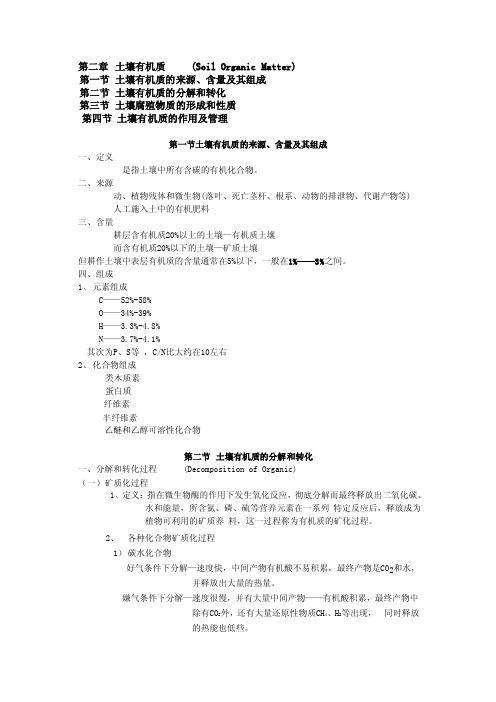
第二章土壤有机质 (Soil Organic Matter)第一节土壤有机质的来源、含量及其组成第二节土壤有机质的分解和转化第三节土壤腐殖物质的形成和性质第四节土壤有机质的作用及管理第一节土壤有机质的来源、含量及其组成一、定义是指土壤中所有含碳的有机化合物。
二、来源动、植物残体和微生物(落叶、死亡茎杆、根系、动物的排泄物、代谢产物等)人工施入土中的有机肥料三、含量耕层含有机质20%以上的土壤—有机质土壤而含有机质20%以下的土壤—矿质土壤但耕作土壤中表层有机质的含量通常在5%以下,一般在1%——3%之间。
四、组成1、元素组成C——52%-58%O——34%-39%H——3.3%-4.8%N——3.7%-4.1%其次为P、S等,C/N比大约在10左右2、化合物组成类木质素蛋白质纤维素半纤维素乙醚和乙醇可溶性化合物第二节土壤有机质的分解和转化一、分解和转化过程 (Decomposition of Organic)(一)矿质化过程1、定义:指在微生物酶的作用下发生氧化反应,彻底分解而最终释放出二氧化碳、水和能量,所含氮、磷、硫等营养元素在一系列特定反应后,释放成为植物可利用的矿质养料,这一过程称为有机质的矿化过程。
2、各种化合物矿质化过程1)碳水化合物好气条件下分解—速度快,中间产物有机酸不易积累,最终产物是CO2和水,并释放出大量的热量。
嫌气条件下分解—速度很慢,并有大量中间产物——有机酸积累,最终产物中除有CO2外,还有大量还原性物质CH4、H2等出现,同时释放的热能也低些。
2) 脂肪、树脂、蜡质、单宁等在好气条件下—除生成CO2和水,并放出能量外,还常产生有机酸在嫌气条件下—则可产生多酚类化合物,氧化可转化为酮类化合物,也可通过聚合、缩合等作用,形成土壤沥青。
3) 木质素类不同植物的木质素,都含芳香核,是一类成分和结构都极复杂的有机化合物,是最不易分解的有机成分。
在好气条件下—主要通过真菌和放线菌的作用,先进行氧化和脱水,再缓慢分解,其芳香核变为醌型化合物在嫌气条件下—分解极漫,在沼泽泥炭地木质素大量累积。
第二章 土壤有机质 ppt课件

ppt课件
1
土壤有机质(soil organic matter,SOM, O.M)是土壤固相的重要组成部分。不同土壤的有 机质含量有很大的差别。
一般来说,土壤有机质的含量与矿质部分相 比都不多,但对土壤的物理性质、化学性质、生
物学性质以及肥力状况都有重要的影响。
ppt课件
2
有机质的存在形态: • 动植物残体 • 半分解的动植物残体 • 腐殖物质
这是有机残余物中含量最多的一种,其化 学成分相当复杂,分子式可用(C6H10O5)n表示, n的数目大约为5~10,000。
在浓酸、浓碱作用下, 会变成葡萄糖,在微
ppt课件
23
3、脂肪、蜡质和树脂 ( fat, wax and resin )
不溶于水而溶于酒精及苯等有机溶剂 中,性质比较稳定,不易遭受化学分解和 生物分解。
0.40(14)
0.40(54)
范围
0.16-0.43
0.13-0.37
0.16-0.37
平均
0.28(14)
0.21(46)
0.24(33)
范围
0.28-0.72
0.28-0.53
0.30-0.63
平均
0.46(11)
0.40(21)
0.40(38)
ppt课件
华南地区 0.19-0.43 0.34(18) 0.32-0.51 0.38(14) 0.16-0.33 0.23(31) 0.20-0.52 0.31(8)
ppt课件
13
三、土壤有机质的含量
(一)土壤有机质的含量表示方法
有 机 质 的 含 量 通 常 用 “ %” 来 表 示 , 近 年 来,有人开始用“g/kg” 表示。
【精选】土壤有机质PPT资料

3 腐殖质的性质 生物排泄物/分泌物 高等植物根系分泌物,土壤动物排泄物,土壤微生物分泌物;
不溶解的腐殖物质 胡敏素 ★促进土壤微生物活动
1)胡敏酸和富里酸的共性 (据Brady N C)
另一部分转化为较简单的有机化合物(多元酚)和含氮化合物(氨基酸、肽等),提供了形成腐殖质的材料。 高山草原土、亚高山草原土 ★改善土壤结构,增强土壤蓄水通气性
NaOH或NH4OH
土壤 稀溶液处理
不溶解的腐殖物质 胡敏素
HCl或
溶解的暗褐色溶液
H2SO4处 理
沉淀物质 胡敏酸
黄白色溶液 富里酸 (见下图)
土壤腐殖质组分及其分离过程图式
在3类腐殖物质中,胡敏素为与矿物质紧密结合的腐殖质,
其性质不活泼,不能作为独立的腐殖物质存在,所以一般
把土壤腐殖质概括为胡敏酸和富里酸两大组。
③★自促然 进界土碳壤循微环生化必物要活合环动节。物是蛋白质,少量比较简单的可溶性氨基酸,
高山草原土、亚高山草原土
植物残体中的叶绿素等。含硫化合物如硫蛋白, 另外,C/N(25), C/P 重要指标。
腐殖质不是一种单一的化合物,而是一类高分子聚缩物,其主体为腐殖酸及其盐,占腐殖质的85%~90%,称为腐殖物质。
2 腐殖质的种类(分组)
腐殖质不是一种单一的化合物,而是一类高分子聚 缩物,其主体为腐殖酸及其盐,占腐殖质的85%~90 %,称为腐殖物质。其余为微生物代谢所产生的较简 单的化合物,因与腐殖酸紧密结合难以分离,故与腐 殖酸合称为腐殖质。
根据腐殖质在不同溶剂中的溶解度和颜色可分 离出胡敏素、胡敏酸和富里酸3种性质不同的腐殖 物质。
胡敏酸和富里酸同属于高分子有机化合物; ★促进土壤养分的有效化 P及金属元素
《土壤肥料》课件——1.1.7土壤有机质的作用与调节

面
二
有机质在转化中可释放一些小分子的有机酸,它们对土壤中的矿物质有一定的溶解能力,
还可与部分多价金属营养离子形成络合物,提高它们在土壤溶液中的稳定性和对作物的有效
性。
1 土壤有机质的作用
可提高土壤的保肥能力
土壤有机质的主要成分是腐殖质,是土壤中经微生物再合成的一类深色有机化合物的通 称,它们通常占土壤有机质的85%以上。
是指每克(或每千克)干有机物施入土壤后,转化形成的腐殖质的克数(或千克数),腐 殖化系数越高,则土壤中生成的腐殖质就越多,土壤有机质含量就不断增加。
因此,通过调节矿化率和腐质化系数可保持有机质的相对稳定性。
2 土壤有机质的调节 增加土壤有机质
增加土壤有机质必须坚持两个原则:平衡原则和经济原则。就是说土壤有机质要保持相 对平衡,不断培肥地力,又要保持较高的经济效益。
1 土壤有机质的作用 2 土壤有机质的调节
1 土壤有机质的作用
土壤有机质在土壤肥力、作物生长及土壤改良中具有重要的作用。
土壤有机质可提供作物所需的养分
//////// 方
面
一
是因为有机质组成中含有氮、磷、钾、硫等养分,有机质经矿质化后,这些元素转化为
各种盐类供作物吸收利用;
//////// 方
//////// 一
土壤腐殖质由胡敏素、胡敏酸和富里酸三大部分组成,由于胡敏素与土粒结合较紧,一 般不易提取出来,因此将胡敏酸和富里酸合称为腐殖酸。
//////// 二
腐殖酸的整体结构紧密,整个分子表现出非晶质特征,具有较大的比表面积,又是一种 亲水胶体,且带较多的负电荷,因此能与大量阳离子作用生成盐。其分子中含有多种功能团, 表现出多种活性,如离子交换、对金属离子的络合作用、氧化还原性等,从而增强土壤的保 肥能力。
第2章 土壤有机质 《土壤肥料学》课件_500
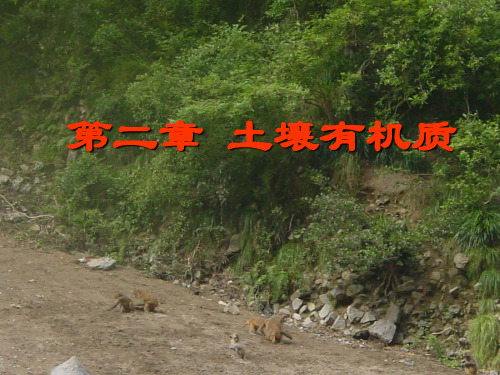
CH2NH2COOH+H2O
HCOOH+CO2 CH3COOH +
CH2(OH)COOH
(3)硝化作用
氨化作用生成的氨或铵盐中,部分的氨态氮可以被 微生物氧化成亚硝酸,并进一步氧化成硝酸的过程, 称硝化作用。这一作用可分为两个阶段:第一阶段, 氨被亚硝酸细菌氧化成亚硝酸;第二阶段,亚硝酸被 硝化细菌氧化成硝酸。其反应如下:
慢分解,并形成一些还原性气体、有机酸,产生的热量
少,称发酵作用。其反应为:
C6H12O6 量
CH3CH2CH2COOH+2H2+2CO2+热
4H2+CO2 CH4+2H2O
2.含氮有机物质的转化 含氮有机物是土壤中氮素的主要贮藏状态,包
括蛋白质、氨基酸、腐殖质等。但植物利用的氮 主要是无机态的氮,如NO3-、NH4+等。 (1)水解作用
3.含磷有机物质的转化
土壤中含磷有机物主要有核蛋白、卵磷脂、核酸、
核素等,它们在有机磷细菌的作用下进行分解:
磷细菌
核蛋白质水解
磷酸 K++Na++Ca磷2+酸盐
产生的磷酸盐是植物可吸收的磷素养分,但在酸 性或石灰性土壤中易与Fe、Al、Ca、Mg等生成难 溶性的磷酸盐,降低其有效性。在缺氧条件下磷酸 又被还原为磷化氢,其反应如下:
第二章 土壤有机质
第二节 土壤有机质
土壤有机质是土壤固相的组成成分之一。它 在土壤的形成过程中,特别是在土壤肥力的发 展过程中,起着极其重要的作用。
我国部分土壤有机质含量如下表。
表 中国某些自然土壤中有机质含量
土类 棕色森林土
有机质含量 (g/kg) 26.4~193
统计的标本数 74
褐土
10.3~106.9
22
黄壤
《土壤有机质》PPT课件
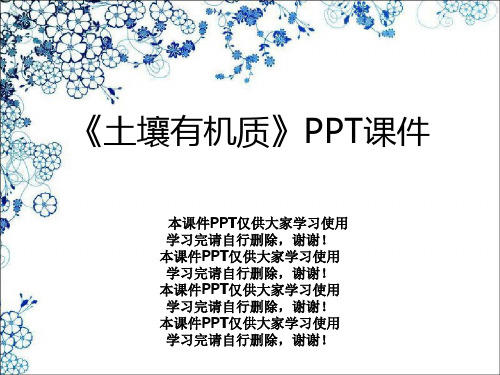
2、土壤湿度和通气状况 (soil humidity and aeration status)
好气:水少气多,M活动旺盛,OM矿质化分解, 释放养分
嫌气:水多气少,M活动受抑制, OM腐殖化合 成腐殖质
3、干湿交替(wetting and drying cycle)
一方面增加土壤呼吸作用,破坏土壤构造体,利 于OM的矿质化分解,另一方面枯燥时引起M死亡, 又不利于OM分解。
由于微生物是土壤有机物质分解和周转的 主要驱动力,因此,但凡能影作用的因素都会 影响有机物质的分解和转化。
1、有机残体特性(specificity of organic relict) 〔1〕物理状态(physical state) :含水多的、嫩的、
多汁的、粉碎的有机物料比含水少的、老的、未粉碎 的物料易分解。
从土壤物理学角度看,有机质的减少,使得土 壤发生退化,耕层变浅;土壤构造的水稳性、力稳性 丧失,容易发生破碎、板结,孔隙性发生劣变,表现 在孔隙数量〔容积〕和质量〔孔隙粗细及其相比照例〕 不协调,不利于土壤水、肥、气、热的协调,土壤的 蓄墒、抗灾、缓冲能力下降,从而影响林木根系发育 和水肥吸收。
影响土壤有机质转化的因素
〔2〕物质组成:含淀粉、纤维素、蛋白质多的物料 较易分解,而木质化的含木质素、单宁、树脂多的物 料较难分解。
〔3〕C/N:大,不易分解 小,易于分解 C、N 都是微生物生命活动所必需的营养,微生物正常
A、假设C/N 比大,如禾本科作物秸秆可达80-100:1,N少, 难以满足微生物需要。假设未经腐熟就施入土壤,会导致当季 作物发生临时饥饿现象〔N hunger, temporary N deficiency〕。
使土壤呼吸强度在很短时间内大幅度地提高,并使其 在几天内保持稳定的土壤呼吸强度,从而增加土壤有
《土壤学》第二章 土壤有机质

• 3、腐殖酸是一种亲水胶体,最大吸水量可以超 过其本身重量的五倍。
➢ 4、腐殖物质整体呈黑色,富里酸颜色较淡,黄色至棕红色, 而胡敏酸的颜色较深,棕黑色至黑色。
➢ 5、腐殖酸的元素组成多:有C、H、O、D、S、Ca、Mg、 Fe、Si等灰分元素。
(四)、改善生物性质
(1)提高微生物活性和数量。 (2)增加土壤养分转化。 (3)促进植物和生物生长发育。
(五)、改善土壤生态环境
(1)减少重金属污染:吸附、包被、络合、 螯合、溶解排出等。
(2)加速对农药等有机污染物的降解。 (3)对全球碳平衡产生影响 :
土壤碳
大气碳
二、提高土壤有机质的措施
►土壤有机质的组成
1.元素组成是C、O、H、N、P、S、K、Na、Ca、Mg等 有机质的含碳量平均为58%,故土壤有机质的含量大致是
有机含碳量的1.724倍。
2.化合物组成
碳水化合物(糖、淀粉、纤维素和半纤维素)、 含氮化合物(主要为蛋白质)、木质素、脂肪、 树脂、蜡质、单宁。
三、土壤有机质的存在状态
31/1 20/1 16/1 13/1 11/1 7/1
• 讨论:秸秆还田或堆肥时为何经常要加 入适量的速效氮肥?
(6)温度 :土壤微生物活动的最适宜的温度大 约范围为25-35摄氏度
(7)土壤水分和通气状况:土壤相对含水量 为60-100%时,水、气都较合适。
(8)土壤酸碱度: 中性土壤转化快
微量元素等各种养分的主要来源。
(二)改善物理性质
(1)促进团粒结构的形成:通过功能团 以胶膜形式包被在矿质土粒的外表 。
(2)改善土壤通气、透水及持水性。 (3)改善耕性,延长适耕期,提高耕作
土壤有机质PPT课件
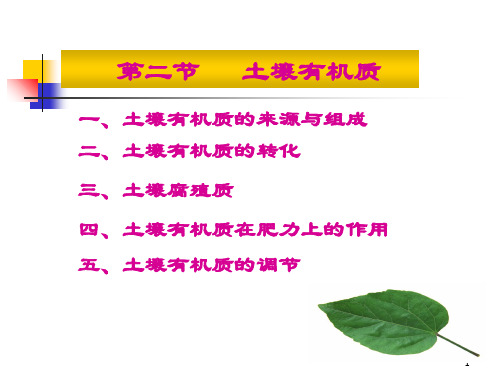
16
胡敏酸和富里酸是土壤腐殖质的主要部 分,一般在60%左右,胡敏素是与土壤矿物 颗粒紧密结合而不能被稀碱液所提取的腐殖 酸,由于与土壤颗粒结合牢固,对土壤性质 和土壤肥力影响不大。
(三)土壤腐殖酸的性质
1、腐殖酸的元素组成
主要是由C、H、O、N、P、S等元素组成。平均含碳为58%, 含氮平均5.6%。其中胡敏酸与富里酸比较,前者含碳、氮高而富 里酸含氧、硫高,富里酸酸性较强。
28
作业
一、名词
土壤有机质 土壤腐殖质
二、论述题
土壤有机质的作用。
29
个人观点供参考,欢迎讨论!
1、非腐殖物质(非特异性物质)指土壤中动植物微生
物残体和它们不同阶段的分解产物。主要有五类有机化
合物和灰分物质,包括:
1)糖类化合物:
单糖双糖和多糖类 好气条件 CO2+H2O
单糖双糖和多糖类 厌气条件 有机酸H2、CH4
2)纤维素、半纤维素
3)木质素
4)含N化合物(蛋白质、氨基酸)
5)脂肪、树脂、蜡质和单宁
我国部分土壤有机质含量如下表:
4
我国部分自然土壤有机质含量如下表。
土类
有机质含量(%) 统计的标本数
棕色森林土
2.64~19.3
74
褐土
1.03~10.69
22
黄壤
2.71~20.5
32
红壤
0.52~1.95
47
黑土、黑钙土
2.14~16.4
29
砖红壤、赤红壤
2.32~2.98
24
高山草甸土、亚高山草甸土 4.81~21.96
2、 腐殖酸含有多种含氧功能团并带有电荷
含有多种含氧功能团如羧基、酚羟基、羰基、甲氧基、醌基和 醇羟基、胺基、硫醇基等,使腐殖酸具有生理活性,能发生许多 生化反应如离子交换、络合、氧化还原等; 另外腐殖酸还是两性胶体,在不同酸碱度的介质中电性不同,可 以解离使腐殖质分子表面带有电荷。(如—COO-、—NH3+)
(土壤学教学课件)第二章-土壤有机质

(一)土壤腐殖质的分组
腐殖酸
溶 富里酸
稀HCl 液 Fulvic acids
溶
除去动植 稀NaOH 液
沉
淀 胡敏酸
腐
Humic acids
殖 质
物残体的
细土样
沉淀
胡敏素
Humin
Flaig的胡敏酸(HA)分子结构模型
阳离 子交 换量 大
小
HA/FA比值越大,说明胡敏酸的含量越高, 腐殖酸的结构愈复杂。
我国北方大多数土壤,以胡敏酸为主, HA/FA > 1
南方土壤中,富里酸占优势, HA/FA < 1
四、影响土壤有机质转化的因素
–微生物是土壤有机质分解和周转的驱动力,凡是影 响微生物活动及其生理作用的因素均会影响有机质 的分解和转化。
-提高土壤温度的作用 有机质为暗色物质,一般是棕色到黑褐色,
吸热能力强,可改善土壤热状况。
• 有机质在生态环境上的作用
– 与重金属离子的作用
各种功能团对金属离子的亲和力:
烯醇基 > 胺基 > 偶氮化合物 > 环氮 > 羧基 > 酰基> 羰基
螯合物:两个以上的功能团与金属离子形成 的环状络合物。
腐殖质与金属离子络合的稳定常数:
对农药等有机污染物有很强的亲和力,对有 机污染物在土壤中的生物活性、残留、生物 降解、迁移和蒸发等过程有重要的影响。
– 全球碳平衡 土壤有机质是地球上非常重要的碳库:
全球土壤有机质总C量: 陆地生物总C量:
1415×1017g 5.6×1017g
土壤有机质分解释放到大气的总C量: 68×1015g/年 燃料焚烧释放到大气的总C量: 6×1015g/年
《土壤肥料》课件——1.1.6土壤有机质的组成及转化

1 土壤有机质的概念及来源 2 土壤有机质的含量及组成 3 土壤有机质的矿质化过程 4 分解与转化
1 土壤有机质的概念及来源
土壤有机质的概念
是指存在于土壤中的所有含碳的有机物质。它包括土壤中各种动物、植物残体、微生 物及其分解合成的各种有机物质。
土壤有机质是由生命体和非生命体两大部分有机物质组成。
土壤有机质含量
对于一般的农业土壤而言,土壤有机质的干重只占土壤干重的1%~5%之间,但它对 土壤理化性质和肥力的作用要远大于它在重量上所占的比例。
土壤有机质的组成
土壤有机质组成主要有糖、有机酸、醛、醇、酮及其相近的化合物;纤维素、半纤维 素;木质素;脂肪、蜡质、树脂等以及含氮化合物和灰分物质等。
3 土壤有机质的矿质化过程
由于微生物生命活动需要的碳氮比约为25,若有机物的C/N<25,则分解时有多余的氮 素释放出来,可供作物吸收利用,且分解速率不受影响;
若C/N>25,则微生物自身所需的氮素不足,使有机质的分解速率减慢,并发生微生物 与作物争氮现象而不利于作物的生长。所以,在施用碳氮比较大的有机肥时,为避免出现 这种争氮现象,一般应补充无机氨肥。
4 分解与转化
土壤有机质分解转化的影响因素
///// 土 壤 通 气 状 况 在通气良好,有利于矿质化作用,有机质分解迅速,腐殖质难于积累;而在通气不良
的土壤中,矿质化慢而有利于腐殖质积累。
///// 土
壤
水
分
土壤含水量越高,则土壤的通气性越差,则有利于腐殖化作用;反之,有利于矿质化 作用。最适宜的土壤水分含量为土壤田间持水量的60%~80%有利于微生物的活动。
葡萄糖在土壤通气良好的条件下,直接分解成 二 氧 化 碳 和 水 。在通气较差,或氧气含 量较低的土壤中,葡萄糖则被微生物分解成小分子的有机酸,如果土壤继续通气不良,则 这些小分子酸可进一步转化成还原性极强的甲烷等,这也是稻田容易产生甲烷的原因之一 。
《土壤有机质》PPT课件

〔三〕土壤特性
土壤质地: 与粘粒含量具有极显著的正相关 粘重的土壤通常比砂质土壤含有更多的有机质 〔 通常 52-98% 的土壤有机质集中在粘粒部分〕
土壤pH:通过影响微生物的活性而影响有机质的降解
土壤微生物活动的pH范围
微生物种类
细菌
真菌 放线菌 原生动物
腐败细菌 根瘤菌 自生固 N 菌 硝化细菌 硫细菌 霉菌
二、 土壤有机质转化的承担者——土壤微生物
土壤中微生物 分布广 数量大 种类多 最活跃
1公斤土壤可含: 5亿个微小动物。 5亿个细菌, 近10亿个真菌
100亿个放线菌
它们参与土壤有机质分解,腐殖质合成,养分 转化和推动土壤的发育和形成.
二、土壤有机质的转化
包括在微生物作用下的矿质化和腐殖化两种过程.
第二节 土壤有机质在肥力上的 作用及其动态平衡
一 、有机质的作用 〔一〕有机质在土壤肥力上的作用
1、提供植物需要的养分 直接提供:土壤有机质是作物所需的氮、磷、硫、微 量元素等各种养分的主要来源.
间接作用:多种有机酸和腐殖酸对土壤矿质部分有一 定的溶解能力,可以促进矿物风化,有利于某些养料 的有效化.一些与有机酸和富里酸络合 的金属离子可以保留于土壤溶液中 不致沉淀而增加有效性.
碳水化合物
含氮有机物 含磷有机物 含硫有机物
〔好气〕碳水化合物→有机酸→ CO2↑ +H2O 〔嫌气〕碳水化合物→有机酸→ CH4 ↑ +H2O
〔氨化〕蛋白质→氨基酸→ NH3 ↑ +H2O → NH4 + 〔氨态氮〕 〔硝化〕 NH3 → HNO2 → HNO3 → NO3 -〔硝态氮〕 〔反硝化〕 核蛋C白6→H1核2O素6→+2核4K酸N→O3H→3P2O44KH→COH23P+O64C-O或2H+P1O24N2O-<2有↑+效18态H2磷O> 卵磷脂→甘油磷酸脂→H3PO4 → H2PO4-或HPO42-〔有效态磷〕
- 1、下载文档前请自行甄别文档内容的完整性,平台不提供额外的编辑、内容补充、找答案等附加服务。
- 2、"仅部分预览"的文档,不可在线预览部分如存在完整性等问题,可反馈申请退款(可完整预览的文档不适用该条件!)。
- 3、如文档侵犯您的权益,请联系客服反馈,我们会尽快为您处理(人工客服工作时间:9:00-18:30)。
C/N比( carbon nitrogen ratio )
Compounds released as waste by one organisms can often be used as food by another
Soil Organic Matter =SOM
SOM
is labile* -it can decline rapidly if the soil
气体,产生环境效应,也影响植物生长。
水田不宜提倡秸秆还田。不能以牺牲环境为代价,换取增产。 干土效应( effect of soil drying):土壤经过干燥后,在加水湿润的最 初1~2周内,二氧化碳和氨释放量增加的现象。
一.有机质的矿化作用 mineralization
(四)影响土壤有机质分解转化的因素
C/N比:有机质中有机碳和有机氮的重量比 土壤的C/N: 8:1~15:1 中间值为10:1~12:1。在同一气候条件下,C/N变化 较小。气温相同时,干旱气候条件下的C/N比湿润地带低;降雨量
相同时,暖温地带土壤C/N比寒冷地土壤低。底层土壤C/N比表层土
壤低。 植物的C/N比:豆科植物20:1~30:1。作物秸秆为80:1~100:1 微生物:4:1~9:1
Leaf Humus
(三)组成及性质
SOM consists of a broad spectrum of chemical
classes,
including amino acids(氨基酸), lignin(木质素), polysaccharides ( 多 聚 糖 ) , proteins ( 蛋 白 质 ) , cutins(角质), chitins(壳质), melanins(黑色素), suberins( 软 木 脂 ) , and macromolecules, as well
2.水分(通气性):
微生物生命活动一切条件都需要一定的湿度条件和通气条件。如果适 度湿润且通气良好,土壤中的好气微生物活动旺盛,有机物质进行着好气分 解,分解速度快。分解完全,矿化率高。中间产物少。养料释放多。不会产 生有毒物质。如果湿度过大,水分堵塞了土壤孔隙,使通气状况受阻,嫌气 微生物活动旺盛,有机物质分解慢,不彻底,有中间产物累积,释放还原性
SOM
Rapid
• Plants, manure
Humus
• Stable
• Energy for microbes
• Cements crumbs
• Holds water
In 1 teaspoon of soil there are…
Bacteria
Fungi Protozoa
1.为作物生长释放出了营养元素---有效化过程(硝化力测定)
2.为腐殖质形成提供了基本材料,成为腐殖化的前提。
一.有机质的矿化作用 mineralization
(三)各种物质矿化作用 1.糖类有机物质矿化:
多糖
单糖
水解酶作用
CO2+H2O+heat(多) 好气条件下 有机酸+heat(少) 半嫌气条件 CH4、H2、H2S+heat(极少)嫌气
Residue(残体) of life
Living Roots Earthworms and insects Microorganisms Dead Fresh plant residues Recently deceased(死亡的) soil organisms Active organic matter Very Dead Well decomposed(腐解的) organic materials Humus(腐殖质)
己糖>淀粉>半纤维素>纤维素;糖类物质的分解是土壤中 生物物活动的主要能源(生物热)。(4~5千卡热/克有机物)
一.有机质的矿化作用 mineralization
2.含氮物质的分解 蛋白质 多肽
蛋白酶 肽酶
氨基酸
氨NH3
氨化细菌
硝酸根NO3硝化细菌
硝化作用 (nitrification)
水解作用 (hydrolyzation)
Nematodes Arthropods Earthworms
Travis & Gugino - PSU
Fresh Residues
Up to 15% of organic matter is fresh residue Comprised mainly of litter fall Much can be recognized as plant residue
Stabilized organic matter acts like a sponge and can absorb six times its weight in water
HUMUS
Newly-formed humus a) combination of resistant materials from the original plant tissue, b) compounds synthesized as part of the microorganisms' tissue which remain as the organisms die. (Fluvic and Humic Acid) humus is resistant to further microbial attackN and P are protected from ready solubility.
性都会降低,有机物质分解速率变慢。高于50 ℃就是纯氧化反应。
(南方土壤有机质含量为什么低于北方土壤?) 冻土效应(effect of soil freezing) 土壤冰冻以后,在其解冻后的最初1~2 周内,二氧化碳和氨释放量增多的现象。
一.有机质的矿化作用 mineralization
(四)影响土壤有机质分解转化的因素
第二章 土壤有机质
Chapter 2: soil organic matter
第一节 第二节 第三节 有机质的来源、类型及组成(了解) 土壤有机质的转化(掌握) 有机质的作用及调节(掌握)
What is Soil?
Organic Air
Mineral
Water
土壤有机质是土壤固相的重要组成部分; 在一般土壤中,有机质含量在5%以下;
嫌气条件
(三)矿化率(mineralization rate): 每年因矿化而消耗的有机物质量占土壤有机质总 量的百分数。 矿化率作为土壤矿化快慢的指标。一般土壤年矿化 率为1%左右。
ห้องสมุดไป่ตู้
一.有机质的矿化作用 mineralization
(四)影响土壤有机质分解转化的因素
土壤有机物质分解转化是在微生物的作用下进行的,属于生物化学反应。 1.温度: 在0~35℃范围内,随着温度升高,有机物质分解速率增加。每上升10 ℃,土壤有机质分解速率升高10倍。温度高于45 ℃和低于0 ℃微生物的活
as organic chemicals produced by humans.
土壤有机质来源物的组成成分
植物残体含水量一般在60-90%;
干物质中,90%以上为C,H,O三元素,N和灰分元 素约占8%;
植物残体的有机化合物包括:
---碳水化合物,约占干物质的60%; ---脂肪、腊质、鞣酸等,1-8%; ---木质素:10-30%; ---蛋白质:1-15%;
* Labile = Constantly or readily undergoing chemical, physical, or biological change or breakdown; unstable.
Stable Organic Matter -Humus
Thus, soil organic compounds become stabilized and resistant to further changes by microorganisms
第二节 土壤有机物质的分解与转化 Decomposition of organic Matter
矿(质)化作用
mineralization
有机残体
腐殖化作用
humification
一.有机质的矿化作用 mineralization
(一)矿化作用的概念(Mineralization ):
有 机物 质在微 生物 的作用 下分 解成无 机营 养元素 的过 程 (The conversion of an element from an organic form to an inorganic state as a result of microbial decomposition)。 (二)矿化作用的意义
氨化作用 (ammonification)
任何条件下
好气条件下
思考题:旱地和水地含氮化合物的转化结果会有何差异?
一.有机质的矿化作用 mineralization
3.含磷和硫化合物的分解
正磷酸盐H2PO4-、HPO4=、PO4+3、 正硫酸盐 HSO4-、SO4=
好气条件
含磷和硫化合物的分解
偏磷酸盐和次磷酸盐H3PO3、 H3PO2 、H3P 正硫酸盐 H2S (黑根、毒害)
3.pH: 各类微生物最适条件:细菌—中性;放线菌—偏微碱性; 真菌— 酸性(3~6);土壤pH高于8.5和低于5.5,都不适宜微生物活动。绝大多 数微生最适pH条件为中性。 4.有机物的物理状态和组成: 新鲜程度、细碎程度,织物组织的C/N比
C/N比( carbon nitrogen ratio )
